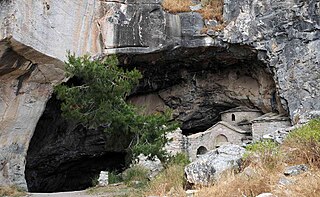 W
WThe Alepotrypa cave is an archaeological site in the Mani region of the Peloponnese peninsula. In addition to being inhabited by early farmers, this site was used for burial and cult purposes. Archaeological evidence has revealed that this is one of the largest Neolithic burial sites ever found in Europe. Two adult human skeletons were found at the site from a burial dating to the 4th millennium BC, as well as remains from at least 170 separate persons. Archaeologists are uncertain about the significance of a Mycenaen ossuary, which has been dated to the 2nd millennium BC and appears to have been reburied at Alepotrypa. While there is no direct evidence, it is possible that the ossuary may link Alepotrypa to Tainaron, which was regarded as the entrance to Hades in classical mythology.
 W
WThe Apidima Cave is a complex of four small caves located on the western shore of Mani Peninsula in southern Greece. A systematic investigation of the cave has yielded Neanderthal and Homo sapiens fossils from the Palaeolithic era.
 W
WArkaliospilio is a cave located to the south west of Marathos. The entrance is 2.1 meters wide and 1 meter high. A large part of this cave is still unexplored.
 W
WArkoudiotissa is a cave in the municipality of Akrotiri on the Greek island of Crete. From Gouverneto Monastery, the path to the cave is only accessible by foot. Arkoudiotissa ("she-bear"), is noted for its stalagmite which is said to look like a bear. This cave is believed to have been used for worship since ancient times, but was dedicated to the Arkoudiotissa Panaghia during the Christian era. Ascetics lived in the caves in the area.
 W
WBlue Cave is the most celebrated attraction of the Greek island of Kastellorizo, and is a sufficient reason to visit the island . The cave lies on the southeast coast of the island, and is named by the inhabitants phokialí.
 W
WThe Cave of the Lakes, formerly called Troupisio, is located near the village Kastria in the Achaea regional unit. It is 17 km from Kalavryta and 9 km from Kleitoria.
 W
WThe Corycian Cave is located on the slopes of Mount Parnassus, in central Greece. In the mythology of the area, it is named after the nymph Corycia; however, its name etymologically derives from korykos, "knapsack". A modern name for the cave in some references is Sarantavli, meaning "forty rooms". This cave was sacred to the Corycian nymphs and the Muses, and a place of worship for Pan.
 W
WDavelis Cave is a well-known cave in Penteli, a mountain to the north of Athens, Greece.
 W
WDoxa is a small but well-known cave in Marathos.
 W
WFranchthi Cave or Frankhthi Cave is an archaeological site overlooking Kiladha Bay, in the Argolic Gulf, opposite the village of Kiladha in southeastern Argolis, Greece.
 W
WKlithi or Kleidi Cave is located to the north of the village of Kleidonia in the Ioannina regional unit and around 500 m (1,600 ft) west of the Megalakkos Cave, northwestern Greece. It is situated atop the northern bank of the Voidomatis river valley.
 W
WThe Megalakkos is a rock shelter located north of the village of Kleidonia in the Ioannina regional unit and around 500 m (1,600 ft) east of the Kleidi Cave, northwestern Greece. It sits atop the northern bank of the Voidomatis river valley.
 W
WThe Petralona cave also Cave of the Red Stones, a karst formation, is located at 300 m (984 ft) above sea-level on the western foot of Mount Katsika, about 1 km (0.62 mi) east of the village of Petralona, about 35 km (22 mi) south-east of Thessaloniki city on the Chalkidiki peninsula, Greece. The site came to public attention when in 1960 a fossilized archaic human skull was found. The cave had been discovered accidentally only a year earlier (1959) after erosion had left clefts in the rock. "Bejeweled" with impressive stalactite and stalagmite formations and holding an abundance of fossils, the cave soon attracted geologists and paleontologists. After decades of excavations the cave is open to the public and scientific work is documented and presented in an adjacent archaeological museum.
 W
WThe Phyle Cave is a small cave on Mount Parnes near Fyli (Phyle), a suburb of Athens in Attica, Greece. In ancient Greece it was the site of a sanctuary to Pan and the nymphs. It is also known as Lychnospilia for the large number of oil lamps found in the cave. It has been identified as the cave which occurs in the Dyskolos of Menander. The cave was excavated in 1901. Three votive reliefs found in the cave are now on display in the National Archaeological Museum of Athens.
 W
WSacred caves and peak sanctuaries are characteristic holy places of ancient Minoan Crete. Most scholars agree that sacred caves were used by the Minoans for religious rites. While all peak sanctuaries have clay human figurines, only Idaeon and Psychro have them among the sacred caves. Clay body parts, also called votive body parts, common among peak sanctuaries, appear in no caves with the exception of a bronze leg in Psychro.
 W
WSykia is a small doline in Athens, Greece.
 W
WTheopetra Cave is located in Thessaly, Greece, on the north-east side of a limestone rock formation, 3 km (2 mi) south of Kalambaka. The site has become increasingly important as human presence is attributed to all periods of the Middle and Upper Paleolithic, the Mesolithic, Neolithic and beyond, bridging the Pleistocene with the Holocene.
 W
WThe Vari Cave, also known as the Nympholyptos Cave, is a small cave northeast of Vari in Attica, Greece. In classical antiquity the cave was used as a shrine dedicated to Apollo, Pan and the Nymphs. The cave was occupied from the sixth to second century BC. The cave then fell into disuse until it was occupied again in the fourth century AD. It was finally abandoned in approximately the sixth century. The cave was excavated in 1901.